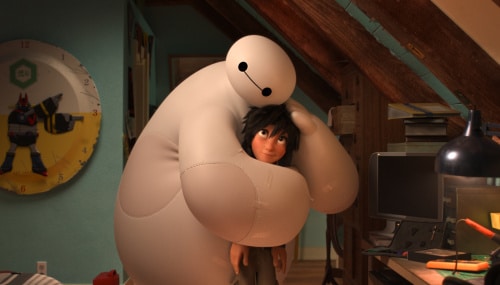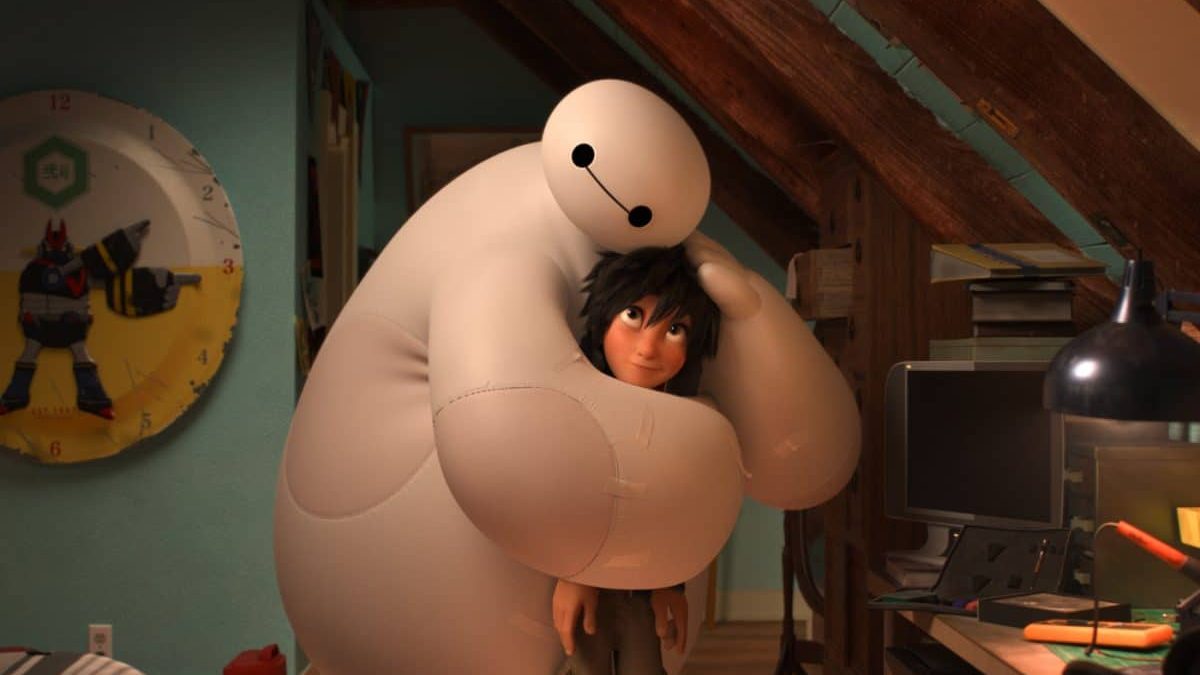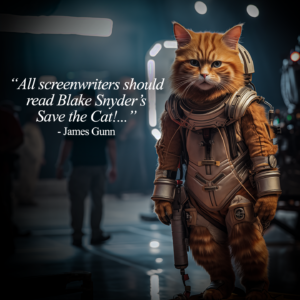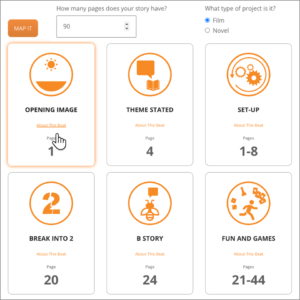
Screenplay by: Jordan Roberts and Daniel Gerson & Robert L. Baird
Based on the characters created by (as Man of Action) Duncan Rouleau, Steven T. Seagle
Head of Story, Paul Briggs & Joe Mateo
Directed by: Don Hall, Chris Williams
Genre: Superhero
Opening Image: The film opens with the sprawling city of Sanfransokyo, a city that resembles San Francisco blended with Japanese culture.
Set-Up: Hiro Hamada, a prodigy who graduated from high school at age 13, spends his time building homemade robots to fight in illegal underground rings. Not only is Hiro smart, he is clever. He tricks everyone into thinking that he is just a clueless kid, and in a save the cat moment, he wins us over as he defeats the current champion in a robot fight. He is threatened, but his older brother Tadashi comes to his rescue.
Theme Stated: Tadashi scolds Hiro for his actions, noting that while he is brilliant, he needs to use his brains to help people. Even though Hiro appears to be content wasting his life and talents away, it’s a clear stasis=death scenario. Unless Hiro decides to do something with his intelligence, he will never make the mark he is capable of. Tadashi tells Hiro, “I’m not giving up on you,” a statement that carries the theme. Through the events of the story, Hiro will learn how to use his intelligence to face impossible odds, relying on his friends to help him persevere.
Set-Up (continued): After arriving home, Hiro is greeted by his Aunt Cass, who has raised the two boys after their parents had died. Hiro asks Tadashi to take him to another illegal robot fight. To Hiro’s surprise, Tadashi agrees, but instead takes him to his university, which Hiro calls “Nerd School.” However, upon entering the lab, Hiro meets several of Tadashi’s classmates, all geniuses like him. Honey Lemon spends her time concocting chemical combinations. Go Go Tomago experiments with speed, building a cycle that uses magnetic wheels to eliminate friction. Wasabi has designed lasers that can slice through anything, while Fred is simply a friend who hangs around due to his interest in science (and comic books).
Tadashi shows Hiro his project, an inflatable robotic healthcare nurse named Baymax. Baymax is guided by a chip Tadashi made, and he even seems to have a personality. Hiro meets the esteemed Professor Callaghan, Tadashi’s mentor. All of this intelligence in one room excites Hiro and invigorates him, and he wants to apply to the university.
Catalyst: To get into “Nerd School,” Hiro must invent something to show off at the university’s exhibition, his ticket to earning a personal invitation to attend as a student.
Debate: Hiro must decide what to invent. He struggles with creating something that will amaze Callaghan and those in attendance, and his brother encourages him to look at things from a different angle. Spying his robot from the illegal bot fight earlier, he begins to brainstorm.
What will it take to move Hiro from his ordinary thesis world to one that is completely different? He works tirelessly, filling container after container with his inventions until his makeshift lab in his garage is full. On the day of the exhibition, he arrives, nervous, as he prepares to unveil his creation. But will it be enough to garner him an invitation?
As the time comes to present, Hiro takes to the stage. Using a headband that functions on his brainwaves, Hiro unveils his invention: microbots that swarm and can form whatever he thinks of. The invention clearly amazes the crowd, as well as Tadashi’s friends and Professor Callaghan. They quickly accept Hiro into their fold as one of them. Hiro’s microbots draw the attention of billionaire Alistair Krei, who wants to buy them from him. At Callaghan’s warning of Krei’s unethical experiments, Hiro resists instant fame and fortune.
As the evening ends and Hiro heads home with Tadashi, the exhibition hall erupts into flames. Tadashi runs back in to save his mentor, but an explosion rips through the building, killing Tadashi. This is the double bump that will propel Hiro into Acto Two.
Break into Two: After the funeral, Hiro sits in sadness. While getting up, he stubs his toe, and Baymax inflates and scans him, attending to his “injury.”
B Story: Hiro is at first annoyed by Baymax, especially when Baymax notes Hiro’s sad emotional state. However, it is through his relationship with Baymax and Tadashi’s friends that Hiro will learn the meaning of friendship, sacrifice, and perseverance.
Fun and Games: Hiro hears something under his bed and finds a stray microbot wiggling around. He assumes it is malfunctioning, but Baymax notes that it is probably trying to get somewhere. Nonchalantly, Hiro tells Baymax to find out why. Of course, Baymax obeys the command and walks out into the street. Realizing his mistake, Hiro hurries after him, fully entering the antithesis of his world. Now, he will encounter science being used for evil rather than for good, and he will truly need to put his intelligence to the test.
Baymax locates where the one microbot was leading: an abandoned factory. Hiro and Baymax enter, finding that someone has stolen his microbot design and has been reproducing them. He realizes that his microbot was just trying to join the swarm as it was programmed to do. No sooner does he figure this out than the swarm begins to attack him, guided by a mysterious man in a Kabuki mask.
Hiro and Baymax escape, and when the police do not take him seriously, Hiro decides to upgrade Baymax, using a 3D printer to make armor for him and uploading a chip of his design, one that gives Baymax fighting abilities. With the super strength provided by Baymax’s metal skeleton, Hiro is confident that he will be able to take down the man in the mask.
Baymax, however, is more concerned with Hiro’s emotional well-being at the loss of Tadashi. Referring to his programming, he notes that one method for overcoming sadness is spending time with others, and he calls Tadashi’s friends. Meanwhile, Hiro uses the lone microbot in his possession to find the man in the mask. The microbot leads him to a dock, and the Kabuki man emerges from the water, rising on a pillar formed by the swarm. Hiro tries to fight him using Baymax, but it is clear that he is out of his league. Just in time, his friends from the lab arrive, having been called by Baymax. They drive through the city, barely escaping the villain, until their van plunges into the river.
Midpoint: The man in the mask assumes they are dead and leaves. However, Baymax inflates and carries them to safety. Drenched and freezing, Hiro and his friends go to the only safe place they know: Fred’s house. Though he seems to be a bit odd, it turns out that Fred’s family is extremely wealthy. This wealth will come in handy for the team soon. Also, Baymax notes that he had scanned the villain, as his programming requires him to scan every individual he comes in contact with. This gives the team an advantage, as they can use the medical records to learn the individual’s identity. This appears to be a victory for the team, but it is a false victory, as the stakes have raised and evil is tightening its grip.
Bad Guys Close In: Hiro has a plan to determine the identity of the masked man. If he can upgrade Baymax to scan the whole city at once, they can learn the villain’s identity. Using the resources at his disposal, Hiro upgrades not only Baymax, but each member of the team. Focusing on the invention each team member has created as seen in the Set-Up, Hiro gives them their own super abilities. Honey Lemon now has a lot of chemicals at her disposal, allowing her to create whatever the moment calls for. Go Go is fitted with a suit and wheels that allow her to move and to attack quickly. Wasabi gears up with gloves that can project laser blades from his hands, and Fred gets his ultimate dream: a monster suit that allows him to leap high and breathe flames.
Baymax gets new armor along with the ability to fly. Hiro rides along with him, using super-powered magnets to hold on. After an initial test of their abilities, Hiro and Baymax fly high, resting on top of one of the city’s many balloons. Baymax scans everyone at once, ultimately finding the villain’s lair: an island off the coast.
The team arrives at the island and finds the remnants of what looks like a scientific experiment. Furthermore, a video screen shows an image of Alistair Krei, and the team rewinds it, surprised at what they see. In the video, Krei conducted an experiment using teleporters and a test pilot, but when he was warned of abnormal readings, he continued anyway. Something went wrong, and the pilot was lost. Hiro and the team believe that Krei is the one who stole the microbots after showing great interest in them.
When the man in the mask confronts them, the team uses their abilities to stop him, but it is not as easy as they had hoped. Eventually, they remove his mask and the neurotransmitter, and it is revealed that Professor Callaghan is the villain.
Enraged that his brother died trying to save Callaghan, Hiro takes Baymax’s nurse chip out, leaving only the one Hiro programmed. He tosses the nurse chip away, ordering Baymax to destroy Callaghan, and Baymax obeys, throwing everyone aside in his mad fury. Honey Lemon scrambles to find and insert the chip back into Baymax and does so, barely saving Callaghan’s life.
All Is Lost: Callaghan takes back the neurotransmitter and escapes. All Is Lost for Hiro as he is overcome by his anger and grief. The whiff of death is in the air as he realizes that his brother died for nothing, and now the villain has gotten away. Hiro also faces the whiff of death as he realizes that he almost allowed himself to cause the death of someone else, giving in to his anger rather than thinking rationally as his brother would have wanted.
Dark Night of the Soul: As Baymax, now back to normal, flies home with Hiro, Hiro attempts to remove the nurse chip again. He wants his revenge, but Baymax will not open the compartment, asking if killing Callaghan will make him feel better. Hiro realizes that it will not, and Baymax projects a set of videos Tadashi made. The videos show him programming Baymax despite the difficulties he initially had, yet he persevered. As Tadashi tells Baymax, “I’m not giving up on you,” it seems like he is speaking directly to Hiro.
Arriving to find Hiro, Honey Lemon and the team show him something they had found: the video reveals that the test pilot was Callaghan’s daughter, and he was present at the experiment. Just like Hiro, Callaghan wanted revenge. Hiro knows what he must do, taking what he has learned from both worlds: he must rely on his brains to stop Callaghan, not brawn and force, the synthesis of both worlds.
Break into Three: Realizing that Callaghan will try to get revenge on Krei, the team goes to stop him at a public event.
Finale: Callaghan uses the microbots to bring the teleporters to Krei’s company, trying to take away everything Krei has built. Hiro and his friends try to stop him, but the microbots are too powerful. Hiro notices that he can use the portal to break the microbots away from the swarm, rendering Callaghan powerless. He has used his intelligence to solve the problem, and the plan works, defeating Callaghan.
However, the portal is about to explode, and Baymax scans the portal, finding signs of life inside. Callaghan’s daughter is alive, but in a state of hypersleep. Hiro and Baymax enter it, finding her and rescuing her. Baymax is damaged, and he will not be able to leave with Hiro, but notes that his rocket-powered hand can propel them to safety. Digging down deep, Hiro learns to let go and tells Baymax that he is “satisfied with his service,” allowing Baymax to deactivate.
Back in Tadashi’s lab, Hiro stares sadly at Baymax’s gloved fist when something catches his eye. Inside his palm, Baymax has placed his personality chip. Finding another of Tadashi’s prototypes, Hiro inserts the chip, bringing Baymax back.
Final Image: Now complete, Hiro and his friends have become a superhero team, the Big Hero 6. Just as his brother had admonished him, Hiro has learned what it takes to persevere and to use his intelligence—and his heart—to serve and to help others.

Cory Milles
9 Comments
Leave a Reply Cancel reply
You must be logged in to post a comment.










I’m unclear as to how the scene where Hiro tricks the champion bot fighter classifies as a Save the Cat moment. Since Hiro is not helping anyone but rather being deceitful at this moment…I thought this would just simply classify as generally likeable because we admire his pluck/wit? I’m sure I am missing something and I’d love to learn. I’ve researched this point in the books but I’m just not getting my mind around the application of this principle for some reason. :) Could you expound, please?
First off, I loved Big Hero 6 but easily the movie has weak points and I think it suffered from not having a more organized story.
I say this because you have a good argument against that being a good save the cat moment and I have an argument about the catalyst being the go to school or not moment.
I just think this movie wasn’t perfected and has weak save the cat moments AND double catalysts where it pays off only one.
First commenter brings up a good point that the fighting robot victory is more of a intro to Hiro being clever and ahead of his age and likeable than it does bring him into our hearts like a save the cat moment. Yes he does become like able, but to me a TRUE save the cat moment would have been him rescuing a girl who just LOST to that Yama guy and getting her money back. But BH6 writers were more interested in showing him as a selfish person with growth needed to do something that grandiose.
So it WAS a save the cat moment, but a weak one.
As for the catalyst…perhaps I am speaking too fast without checking the timing, but I think the death of his brother is the catalyst. His debate is coming out of his depression and thanks to bay max he chooses to finally get out of his room and decides to find his brothers killer.
But I need to reference the books again to see if my perspective is flawed simply because it occurs too late in the film and those moments could be better midpoints… I just feel like the fun and games are with baymax and the other four heroes until they get to the island. So the catalyst being so early on would be odd to me.
Plus the catalyst of brother death moves the story and is his motivation the rest of the movie. The decision to go to school was just to get him there when his brother died and to get him to make the microbots. After his death, school is mentioned but he never does go back. We only see the other four heroes is because baymax calls them.
Like I said…the movie could have been stronger story wise. But was plenty of fun and baymax is my son’s favorite and mine for life!
Good discussion… I had actually just taken my son to see it a second time after this comment was posted, so it gave me a chance to revisit it. After seeing it a second time, I think the catalyst is still Hiro’s desire to get into the “nerd school.” In the Save the Cat! books, Blake makes a big point about the hero being trapped in a “stasis=death” period of his or her life. In this movie, Hiro is certainly trapped in this, and even his brother tells him that he can’t remain as he is for the rest of his life; he needs to do something with his brain to help people. The catalyst is what takes the hero out of his or her normal life; this event changes the path for them, and had it not happened, the hero would not experience change.
I think his brother’s death is the double-bump needed to truly propel him into Act 2, as during the debate, the viewer questions whether or not Hiro will be able to get into the school. Of course, he does, but it is not until his brother’s death that Hiro is really thrown into the “upside-down” version of his world, one in which his brother is not there to help and to guide him. In fact, it is his brother’s final act that will evidence itself when Hiro comes through the “transformation machine.”
With this viewing, I noticed that while Hiro did not want Tadashi to save his professor from the fire, Tadashi said that there was someone in the building who needed his help, and he made that selfless, heroic act. Hiro shows his complete transformation, becoming like Tadashi, in his “dig down deep” moment, literally echoing Tadashi’s words. When the portal is collapsing on itself, and Hiro realizes Callaghan’s daughter is alive inside, he himself states that “someone is in there” that needs his help. Through Tadashi’s death, Hiro is reborn.
Those are just my thoughts after my second viewing (of what will be many, I am sure!)
Hi Peter!
I think you can take the “Save The Cat” moment during the Bot Fight literally. The ‘cat’ in this moment would be Hiro’s small robot who at first sight doesn’t stand a chance against the goliath robot of the other bloke (who already destroyed another robot of a girl!) This guy and his robot are the danger that destroys other robots (‘cats’).
By destroying the big robot Hiro not even saves his own robot from being destroyed but also many other robots.
To deepen our connection to the ‘cats’, the film not only shows the robots but the people behind the robots. When you see a girl (even if she is a tough one) or a small (at first sight) innocent boy in a fight against a fat mean guy twice their size – whom are you rooting for? Who do you want to win?
I hope that makes it a bit clearer for you. All the best!
Oliver
Hi, Peter! Great question. Of course, Save the Cat often means that the hero does something good to get the audience “on his or her side” and to cheer for him or her throughout the story. However, depending on the hero, it might or might not be something “nice.” It should, however, be a logical extension of that character. Blake discusses this in Save the Cat! Strikes Back on pages 98 and 99. For example, he notes that in The Dark Knight, the Save the Cat moment is when Batman is fighting off the dogs at the beginning, injuring it. While it is not “nice” or a good deed, it gets us to root for him… he is “dark,” after all, but not so much as the Joker, whom we met earlier in the story.
In the case of Hiro, I felt that his Save the Cat moment was, logically, when he showed off his intelligence and wit, defeating the shady robot-fighting champion. Of course, this allowed the story to set up the theme through his brother, Tadashi, who said that Hiro needs to use his intelligence to help others.
That, of course, is my take on it. I’m always interested to see what others think! Thanks for the great question… I love adding clarity to a discussion.
I would contest with the genre chosen; it feels much more like Buddy Love to me. It shares themes with Superhero, yes, but the overriding themes are those about Hiro’s bond with Tadashi and through him Baymax, which definitely seems much more like Buddy Love.
The biggest flaw of Big Hero 6 is that the first 20 minutes of the film have NOTHING to do with the rest of the film thematically.
The first 20 minutes show Hiro’s change from a rebellious, bot-fighting obsessed teen into a slightly more mature person ready to contribute to society, willing to use his talents for the benefit of mankind instead of easy cash for himself.
Problem. Once Tadashi dies, Big Hero 6 becomes a COMPLETELY different film. The theme of the film is no longer “using your talents for the greater good” as the first 20 minutes suggested. It is now “how to deal with loss.”
My point is the movie would’ve been completely fine if it had stuck to one of the two themes throughout the entire film, or used one theme as a subplot to the other. But within the first 20 minutes, there is almost nothing to suggest the film will be dealing with the theme of loss, aside from Hiro mentioning that their parents are dead (which I also thought was cliché and pointless…the movie would’ve not changed in the slightest if the parents were alive and replaced Aunt Cass. It actually might’ve been even more emotional to see Hiro’s parents also deal with the loss of their son).
After the first 20 minutes are over, the film forgets about Hiro’s desire to start attending school and goes into a cool superhero origin story. And that’s all fine and dandy. But other than setting up the characters, the beginning of the film really does nothing for the rest of the movie. Compare that to the beginning of Frozen, which does an excellent job setting up the relationship of the sisters, the emotional basis for the entire film. Or Wreck-It Ralph, which starts off with an equally selfish protagonist whose journey of change defines the movie’s structure.
That’s my biggest pet peeve of the film (there were others, but I’ll leave that out for now). Story-wise, it was pretty lazily written to have the script switch themes mid-film. The theme of loss is quite heavy for a children’s movie, so I understand if the filmmakers were struggling how to deal with it in a “kid-friendly” way. But it’s not impossible to achieve. Look at thematically complex films like the Incredibles or Up. All in all, Big Hero 6 would make a great Saturday morning cartoon. It was just missing the story quality that truly makes Disney films great.
Well put, Josh. I couldn’t agree more.
I loved watching it but a hard time finding the propulsion in break into 2, even after the double bump catalyst.
I think this is where the problem started:
Hiro’s microbot presentation at the college exhibit completely over-succeeds. It’s not an entry test, it’s a genius professorship graduation, compared with the rest of the future tech we meet in the world of BH6!
In a way, his premature college stardom accidentally satisfies his need for change so nicely setup in the illegal bot-fight.
This is why the college catalyst doesn’t get payed off later in the story (it only does in the awesome end credits).
So Hiro needed a second catalyst to jump start his story, but Tadashi’s death didn’t cause propulsion. To be believable, we needed to see Hiro grieve and have time pass until he’s ready to get excited about something.
When Bay Max re-enters and they break into 2 together, Hiro runs out of the cafe. I was unclear about why Hiro needed to hide what was going on from Aunt Cass. Anyone?
So I think the whole Beat Sheet schedule got bumped because of the successful college presentation. The fun and games of building Bay Max into a fighter and upgrading the friends into a superhero team caused the Midpoint to be late – I think it was completing the team upgrade and the first romantic flight ending on a sunset.
‘Bad guys close in’ starts on the island and exposure of the Callaghan portal back story.